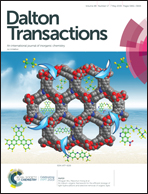Wire like diplatinum, triplatinum, and tetraplatinum complexes featuring X[PtC![[triple bond, length as m-dash]](https://www.rsc.org/images/entities/char_e002.gif) CC
CC![[triple bond, length as m-dash]](https://www.rsc.org/images/entities/char_e002.gif) CC
CC![[triple bond, length as m-dash]](https://www.rsc.org/images/entities/char_e002.gif) CC
CC![[triple bond, length as m-dash]](https://www.rsc.org/images/entities/char_e002.gif) C]mPtX segments; iterative syntheses and functionalization for measurements of single molecule properties†
C]mPtX segments; iterative syntheses and functionalization for measurements of single molecule properties†
Abstract
Reaction of (p-tol3P)2PtCl2 and Me3Sn(C![[triple bond, length as m-dash]](https://www.rsc.org/images/entities/char_e002.gif) C)2SiMe3 (1 : 1/THF/reflux) gives monosubstituted trans-Cl(p-tol3P)2Pt(C
C)2SiMe3 (1 : 1/THF/reflux) gives monosubstituted trans-Cl(p-tol3P)2Pt(C![[triple bond, length as m-dash]](https://www.rsc.org/images/entities/char_e002.gif) C)2SiMe3 (63%), which with wet n-Bu4N+ F− yields trans-Cl(p-tol3P)2Pt(C
C)2SiMe3 (63%), which with wet n-Bu4N+ F− yields trans-Cl(p-tol3P)2Pt(C![[triple bond, length as m-dash]](https://www.rsc.org/images/entities/char_e002.gif) C)2H (2, 96%). Hay oxidative homocoupling (O2/CuCl/TMEDA) gives all-trans-Cl(p-tol3P)2Pt(C
C)2H (2, 96%). Hay oxidative homocoupling (O2/CuCl/TMEDA) gives all-trans-Cl(p-tol3P)2Pt(C![[triple bond, length as m-dash]](https://www.rsc.org/images/entities/char_e002.gif) C)4Pt(Pp-tol3)2Cl (3, 68%). Reaction of 3 and Me3Sn(C
C)4Pt(Pp-tol3)2Cl (3, 68%). Reaction of 3 and Me3Sn(C![[triple bond, length as m-dash]](https://www.rsc.org/images/entities/char_e002.gif) C)2SiMe3 (1 : 1/rt) affords monosubstituted all-trans-Cl(p-tol3P)2Pt(C
C)2SiMe3 (1 : 1/rt) affords monosubstituted all-trans-Cl(p-tol3P)2Pt(C![[triple bond, length as m-dash]](https://www.rsc.org/images/entities/char_e002.gif) C)4Pt(Pp-tol3)2(C
C)4Pt(Pp-tol3)2(C![[triple bond, length as m-dash]](https://www.rsc.org/images/entities/char_e002.gif) C)2SiMe3 (46%), which is converted by a similar desilylation/homocoupling sequence to all-trans-Cl[(p-tol3P)2Pt(C
C)2SiMe3 (46%), which is converted by a similar desilylation/homocoupling sequence to all-trans-Cl[(p-tol3P)2Pt(C![[triple bond, length as m-dash]](https://www.rsc.org/images/entities/char_e002.gif) C)4]3Pt(Pp-tol3)2Cl (7; 79%). Reaction of (p-tol3P)2PtCl2 and excess H(C
C)4]3Pt(Pp-tol3)2Cl (7; 79%). Reaction of (p-tol3P)2PtCl2 and excess H(C![[triple bond, length as m-dash]](https://www.rsc.org/images/entities/char_e002.gif) C)2SiMe3 (HNEt2/cat. CuI) gives trans-Me3Si(C
C)2SiMe3 (HNEt2/cat. CuI) gives trans-Me3Si(C![[triple bond, length as m-dash]](https://www.rsc.org/images/entities/char_e002.gif) C)2Pt(Pp-tol3)2(C
C)2Pt(Pp-tol3)2(C![[triple bond, length as m-dash]](https://www.rsc.org/images/entities/char_e002.gif) C)2SiMe3 (78%), which with wet n-Bu4N+ F− affords trans-H(C
C)2SiMe3 (78%), which with wet n-Bu4N+ F− affords trans-H(C![[triple bond, length as m-dash]](https://www.rsc.org/images/entities/char_e002.gif) C)2Pt(Pp-tol3)2(C
C)2Pt(Pp-tol3)2(C![[triple bond, length as m-dash]](https://www.rsc.org/images/entities/char_e002.gif) C)2H (96%). Hay oxidative cross coupling with 2 (1 : 4) gives all-trans-Cl[(p-tol3P)2Pt(C
C)2H (96%). Hay oxidative cross coupling with 2 (1 : 4) gives all-trans-Cl[(p-tol3P)2Pt(C![[triple bond, length as m-dash]](https://www.rsc.org/images/entities/char_e002.gif) C)4]2Pt(Pp-tol3)2Cl (10, 36%) along with homocoupling product 3 (33%). Reaction of 3 and Me3Sn(C
C)4]2Pt(Pp-tol3)2Cl (10, 36%) along with homocoupling product 3 (33%). Reaction of 3 and Me3Sn(C![[triple bond, length as m-dash]](https://www.rsc.org/images/entities/char_e002.gif) C)2SiMe3 (1 : 2/rt) yields all-trans-Me3Si(C
C)2SiMe3 (1 : 2/rt) yields all-trans-Me3Si(C![[triple bond, length as m-dash]](https://www.rsc.org/images/entities/char_e002.gif) C)2(p-tol3P)2Pt(C
C)2(p-tol3P)2Pt(C![[triple bond, length as m-dash]](https://www.rsc.org/images/entities/char_e002.gif) C)4Pt(Pp-tol3)2(C
C)4Pt(Pp-tol3)2(C![[triple bond, length as m-dash]](https://www.rsc.org/images/entities/char_e002.gif) C)2SiMe3 (17, 77%), which with wet n-Bu4N+ F− gives all-trans-H(C
C)2SiMe3 (17, 77%), which with wet n-Bu4N+ F− gives all-trans-H(C![[triple bond, length as m-dash]](https://www.rsc.org/images/entities/char_e002.gif) C)2(p-tol3P)2Pt(C
C)2(p-tol3P)2Pt(C![[triple bond, length as m-dash]](https://www.rsc.org/images/entities/char_e002.gif) C)4Pt(Pp-tol3)2(C
C)4Pt(Pp-tol3)2(C![[triple bond, length as m-dash]](https://www.rsc.org/images/entities/char_e002.gif) C)2H (96%). Reaction of 3 and excess Me3P gives all-trans-Cl(Me3P)2Pt(C
C)2H (96%). Reaction of 3 and excess Me3P gives all-trans-Cl(Me3P)2Pt(C![[triple bond, length as m-dash]](https://www.rsc.org/images/entities/char_e002.gif) C)4Pt(PMe3)2Cl (4, 86%). A model reaction of trans-(p-tol)(p-tol3P)2PtCl and KSAc yields trans-(p-tol)(p-tol3P)2PtSAc (12, 75%). Similar reactions of 3, 7, 10, and 4 give all-trans-AcS[(R3P)2Pt(C
C)4Pt(PMe3)2Cl (4, 86%). A model reaction of trans-(p-tol)(p-tol3P)2PtCl and KSAc yields trans-(p-tol)(p-tol3P)2PtSAc (12, 75%). Similar reactions of 3, 7, 10, and 4 give all-trans-AcS[(R3P)2Pt(C![[triple bond, length as m-dash]](https://www.rsc.org/images/entities/char_e002.gif) C)4]nPt(PR3)2SAc (76–91%). The crystal structures of 3, 17, and 12 are determined. The first exhibits a chlorine–chlorine distance of 17.42 Å; those in 10 and 7 are estimated as 30.3 Å and 43.1 Å.
C)4]nPt(PR3)2SAc (76–91%). The crystal structures of 3, 17, and 12 are determined. The first exhibits a chlorine–chlorine distance of 17.42 Å; those in 10 and 7 are estimated as 30.3 Å and 43.1 Å.
![Graphical abstract: Wire like diplatinum, triplatinum, and tetraplatinum complexes featuring X[PtC [[triple bond, length as m-dash]] CC [[triple bond, length as m-dash]] CC [[triple bond, length as m-dash]] CC [[triple bond, length as m-dash]] C]mPtX segments; iterative syntheses and functionalization for measurements of single molecule properties](/en/Image/Get?imageInfo.ImageType=GA&imageInfo.ImageIdentifier.ManuscriptID=C9DT00870E&imageInfo.ImageIdentifier.Year=2019)


 Please wait while we load your content...
Please wait while we load your content...

![[triple bond, length as m-dash]](https://www.rsc.org/images/entities/h2_char_e002.gif) CC
CC